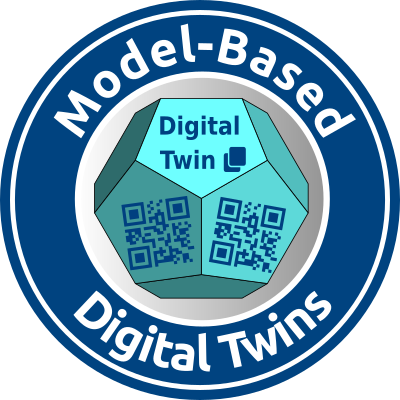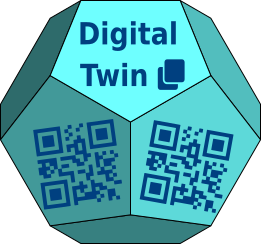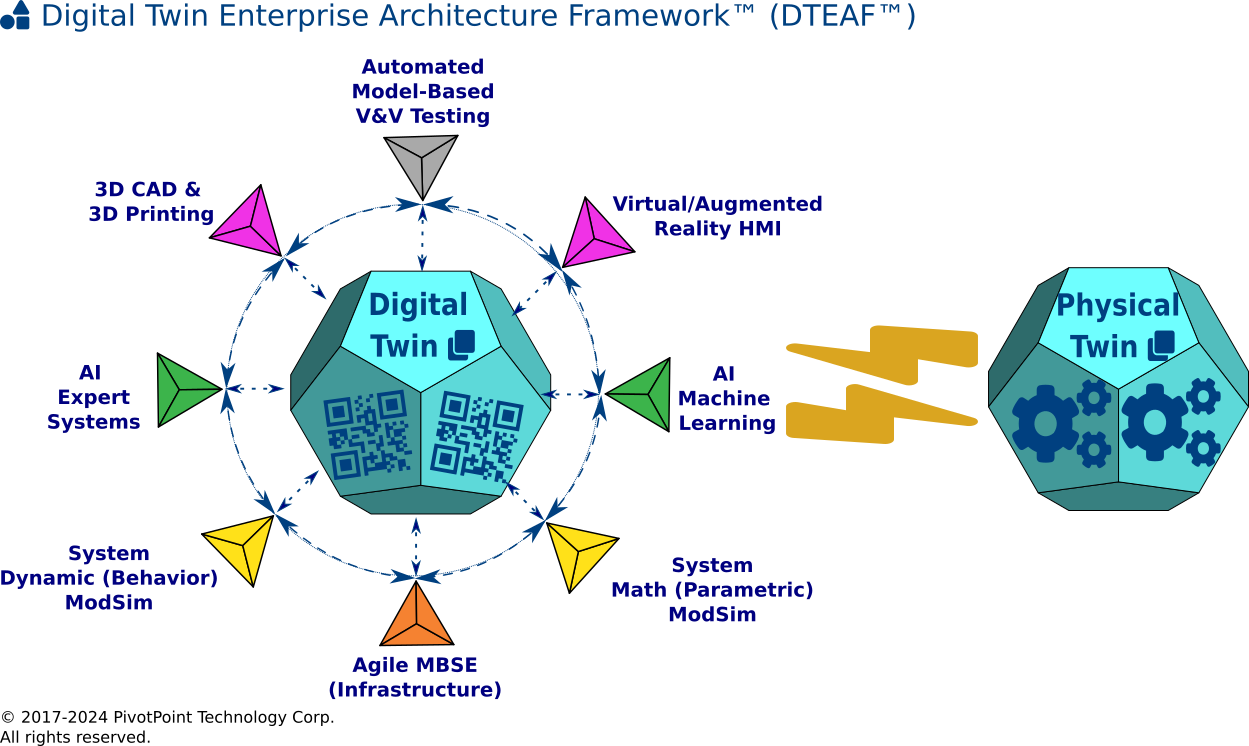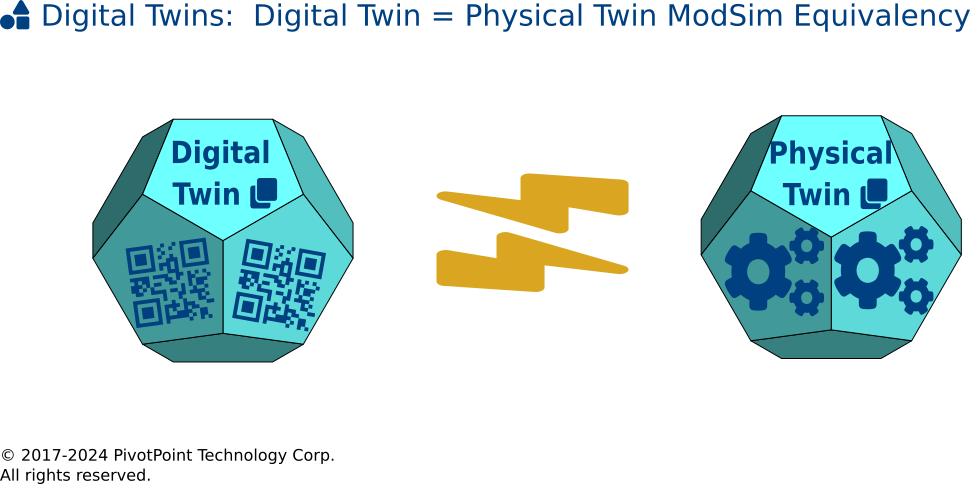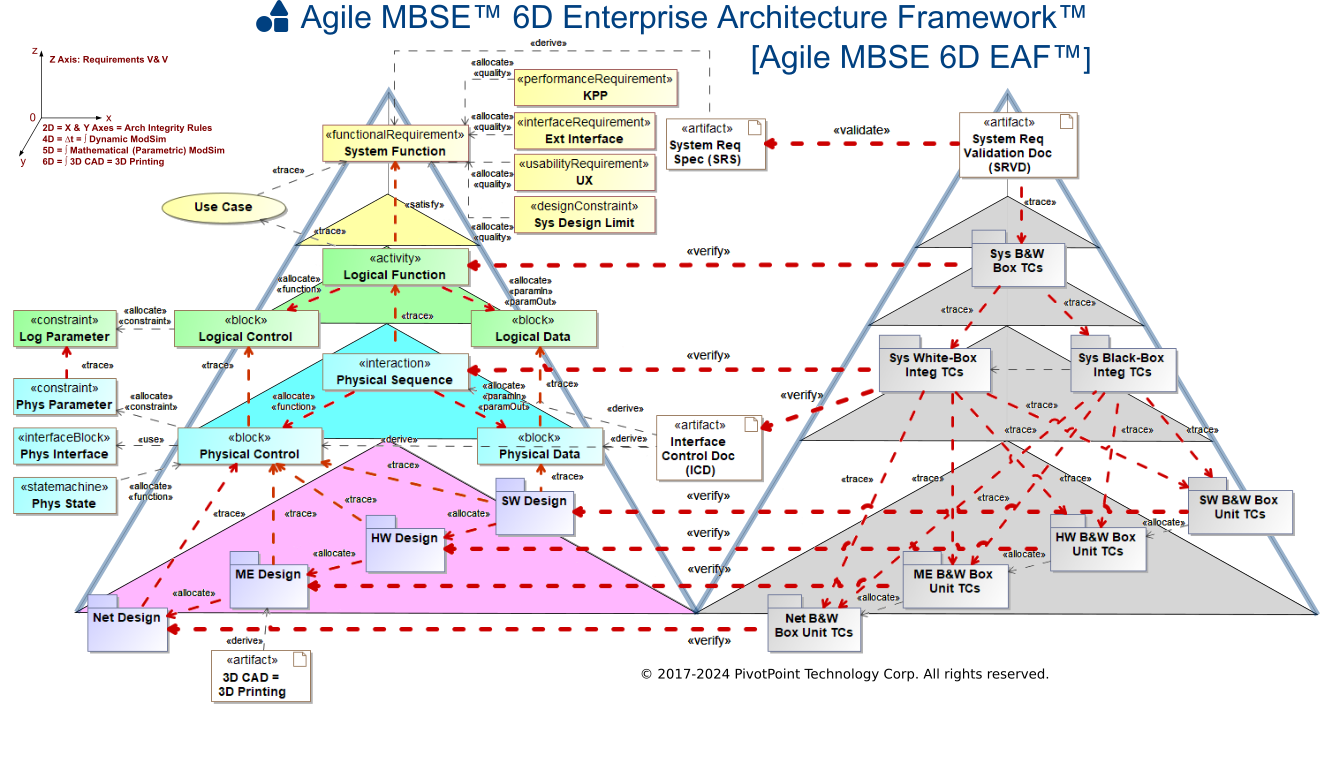Digital Twin & Digital Engineering FAQ
If you have constructive recommendations to correct, clarify, or otherwise improve these or any other Digital Twin & Digital Engineering FAQs, please contact us.
General Questions
What is a Digital Twin? ... Physical Twin?
FAQ Variant(s): What is a Virtual Twin?
Definition
Digital Twin: A Digital Twin is a real-time virtual replica of a real-world physical system or process (i.e., a “Physical Twin”) that serves as its indistinguishable digital counterpart for practical purposes, such as systems simulation, integration, testing, and maintenance. In order to pragmatically achieve indistinguishability between Digital Twins and their Physical Twin counterparts, massive coarse- and fine-grained Modeling & Simulation (M&S) is typically required. From a pragmatic Systems Engineering perspective, Physical Twins represent "Systems-of-Systems" and Digital Twins represent "Simulations-of-Simulations" of "Systems-of-Systems".
Digital Twins are produced by systematically applying Digital Engineering technologies, including both dynamic (behavioral) and mathematical (parametric) M&S, in a synergistic manner that blurs the usual distinctions between real physical systems and virtual logical systems. From a Systems Integration & Testing perspective, a Digital Twin should be indistinguishable from its Physical Twin counterpart. Consequently, Digital Twins can be Verified & Validated (V&V) by the following pragmatic test:
A reasonable litmus test for a "Digital Twin" is analogous to the Turing Test for AI. Suppose you have a System Tester (ST), a Physical System (PS), and a Digital Twin (DT) for PS. If the ST can run a robust system Verification & Validation (V&V) Test Suite on both PS and DT, but cannot reliably distinguish between them with a probability > 80%, ∴ DT is a bona fide Digital Twin of PS.
See also: DE FAQ: What is Digital Twin = Physical Twin M&S equivalency?
What is Digital Engineering?
FAQ Variant(s): What is a Digital Twin?; What is Virtual Engineering?
Definition
Digital Engineering: Digital Engineering is an umbrella term referring to the synergistic application of electronic and software technologies to facilitate the architecture, analysis, design, simulation, building, and testing of complex software-intensive systems-of-systems. The ultimate goal of Digital Engineering is to produce Digital Twins, or digital replicas of real and potential physical assets (i.e., “Physical Twins”) that include both inanimate and animate physical entities (e.g., hardware, software, “wetware” [biological life]), with broad usages and where for Systems Integration & Testing purposes the former are largely indistinguishable from the latter.
Digital Engineering and its associated Digital Twins promise to revolutionize how we architect future Systems-of-Systems. The following interrelated Engineering sub-disciplines will likely play key roles in the Digital Twin technology revolution:
- Agile MBSE technologies provide the architecture infrastructure for recursively scaling and simulating Digital Twins. Agile MBSE technologies are the distillation of a quarter century of lessons-learned from Model-Driven Development (MDD), Model-Based Systems Engineering (MBSE), and Agile/Lean Development technologies, and can provide the recursive architecture and design patterns needed to address the fractal Digital Twin System-of-System challenge.
- Massive Mathematical & Dynamic M&S technologies provide the large-scale Modeling & Simulation (M&S) infrastructure necessary for recursively simulating Physical Twins as Digital Twins. It is essential that mathematical (parametric) and dynamic (behavioral) simulations for Digital Twins are fully integrated and applied on a massive scale. Compare and contrast how massive datas sets and big data fuel Machine Learning (ML) technology. Stated otherwise, if a Physical Twin is a "System-of-Systems", then a Digital Twin is a "Simulation-of-Simulations" for a "System-of-Systems".
- Artificial Intelligence (AI) & Machine Learning (ML) technologies provide the software infrastructure needed for constructing intelligent ("smart") Physical Twins, and by extension their Digital Twin counterparts. Since AI & ML technologies are rapidly transforming how software-intensive Systems-of-Systems interact with humans, these complementary technologies will play a critical role in the evolution of Digital Twin technology.
- 3D CAD & 3D Printing (a.k.a. Additive Manufacturing) technologies provide the electro-mechanical infrastructure needed for the physical construction of Physical Twins, and by extension their Digital Twin counterparts. Since [3D CAD] Design = Implementation [3D Printed Product] is rapidly transforming how we design and manufacture Systems-of-Systems, these complementary technologies will also play a vital role in the evolution of Digital Twin technology.
- Virtual Reality (VR) & Augmented Reality (AR) technologies provide the simulation infrastructure for the massive simulations (Simulation-of-Simulations) required by Digital Twins in order to be indistinguishable from their Physical Twin counterparts. Since VR/AR technologies are rapidly transforming how we interact with Systems-of-Systems, they will additionally play a critical role in the evolution of Digital Twin technology.
How are Digital Twins & Digital Engineering related?
FAQ Variant(s): What is relation between Digital Engineering and Digital Twins?
Digital engineering and digital twins are closely related fields, as digital engineering techniques and tools are often used to develop and maintain digital twins. Digital engineering is an interdisciplinary field that uses a variety of techniques and tools, such as modeling, simulation, and analytics, to design, develop, and analyze complex systems and Systems-of-Systems. Digital twins are digital representations of physical systems or processes, and can be used to simulate, monitor, and optimize the performance and behavior of these systems in real time.
In other words, digital engineering provides the tools and techniques that are used to create, manage, and analyze digital twins, while digital twins provide a means by which to apply these techniques and tools to specific systems and applications. Digital engineering and digital twins are often used together in a variety of applications, such as engineering design, manufacturing, supply chain management, and maintenance.
Overall, digital engineering and digital twins are distinct yet interrelated fields, and they often intersect and inform each other in various ways. Digital engineering provides the methods and tools used to develop and maintain digital twins, whereas digital twins provide a means by which to apply said methods and tools.
Why do we need Digital Twins?
FAQ Variant(s): Why do we need Digital Engineering?
The increasing reliance of our information-age economies and governments on software-intensive Systems-of-Systems makes us progressively more vulnerable to their failures. Due to advances in Artificial Intelligence (AI) and Machine Learning (ML), these Systems-of-Systems are exponentially increasing in size and complexity, and traditional Model-Based Systems Engineering technlogies are insufficient to manage them. Compare and contrast recent Lockheed-Martin F-35 project problems and Boeing 737 MAX MCAS project problems. Consequently, we must seek more robust and scalable solutions to the System-of-System Sprawl (cf. System Ball-of-Mud) anti-pattern, which is a fractal problem.
Fractal problems require recursive solutions. Digital Engineering's recursive "Simulation-of-Simulations" approach to the System-of-Systems fractal problem represents a quantum improvement over traditional MBSE approaches.
What are the practical goals of Digital Twins?
FAQ Variant(s): What practical problems can be solved by Digital Twins (Digital Engineering)?
As software-intensive Systems-of-Systems exponentially increase in size and complexity, engineering disciplines must evolve in parallel to ensure that these systems-of-systems are safe, economical, and reliable. (Compare and contrast Lockheed-Martin F-35 project problems and Boeing 737 MAX MCAS project problems.) Consequently, the goals of Digital Engineering include, but are not limited to:
- specification of scalable System-of-System Architecture Models (SSAM) that can be extended, modified, and maintained in a cost-effective manner over the System Development Life Cycle (SDLC);
- automated of bi-directional traceability of System Function and Non-Functional Requirements from Requirements Specifications to Software/Hardware/Mechanical implementation components on the “Left-Hand Side of the System V-Model”;
- automated generation of error-free software code from System Software Design models;
- automated generation of Systems Integration & Testing (SI&T) specifications (including “black-box” and “white-box” Unit, Integration & System Test Cases) from System Design on the “Right-Hand Side of the System V-Model”;
- automated manufacture of parts and assemblies from 3D CAD System Design models; and
- massive simulation and automated testing of Digital Twins prior to product rollout to prevent costly stopgap kludge fixes (“patches”; e.g., 737 MAX MCAS software patches) and product recalls.
What popular open source and commercial Digital Twin software tools can be used to Model & Simulate (M&S) Digital Twins?
FAQ Variant(s): What are the best free software tools form modeling and simulating Digital Twins?
There are a variety of popular Free & Open Source Software (FOSS) and Commercial Off-the-Shelf (COTS) Digital Engineering software tools that can be used to model and simulate Digital Twins. Some examples of popular open source tools include OpenModelica, OpenDSS, and OpenFOAM, which are used to model and simulate physical systems in a range of domains, including electrical, mechanical, and fluid dynamics. Other examples of popular open source tools include Gephi, NetworkX, and Neo4j, which are used to model and simulate complex networks and systems of interactions.
In addition to open source tools, there are also a number of popular commercial Digital Engineering software tools that can be used to model and simulate digital twins. Some examples of popular commercial tools include Cameo/Cameo Simulation Toolkit, MATLAB/Simulink, Mathematica, MapleSim, Comsol Multiphysics, and Ansys, which are used to model and simulate physical systems in a range of domains, including electrical, mechanical, and fluid dynamics. Other examples of popular commercial tools include IBM Watson Studio, SAP Leonardo, and Siemens MindSphere, which are used to model and simulate complex networks and systems of interactions, as well as to integrate Digital Twins with other data and analytics tools.
Overall, the specific Digital Engineering software tools that are used to model and simulate Digital Twins will ultimately depend on the specific domain and application of the Digital Twin, as well as the specific modeling and simulation requirements of the particular system. Some tools may be more suitable for particular types of systems or applications, while others may be more versatile in nature and therefore applicable to a wider range of domains.
For further information check out the Digital Engineering / Digital Twin Tool Reviews section.
How to Verify & Validate a Digital Twin?
FAQ Variant(s): How to Test a Virtual Twin?
Digital Twins can be Verified & Validated by the following pragmatic test:
A reasonable litmus test for a "Digital Twin" is analogous to the Turing Test for AI. Suppose you have a System Tester (ST), a Physical System Twin (PT), and a Digital Twin (DT) for PT. If the ST can run a robust system Verification & Validation (V&V) Test Suite on both PT and DT, but cannot reliably distinguish between them with a probability > 80%, ∴ DT is a bona fide Digital Twin of PT. — Digital Engineering Group
What is Digital Twin Modeling & Simulation (ModSim) equivalency?
FAQ Variant(s): How are Digital Twins related to other Digital Twins?
Consider that Digital Twins can be Verified & Validated (V&V-ed) using the pragmatic test described in DE FAQ: How can one Verify & Validate (V&V) a Digital Twin? and reproduced below:
A reasonable litmus test for a "Digital Twin" is analogous to the Turing Test for AI. Suppose you have a System Tester (ST), a Physical System Twin (PT), and a Digital Twin (DT) for PT. If the ST can run a robust system Verification & Validation (V&V) Test Suite on both PT and DT, but cannot reliably distinguish between them with a probability > 80%, ∴ DT is a bona fide Digital Twin of PT. — Digital Engineering Group
It consequently follows that, from a Systems Integration & Testing perspective:
IF DT1 = digitalTwin(PT) AND DT2 = digitalTwin(PT)
THEN DT1 ≈ PT ≈ DT2
Compare and contrast Turing Machine equivalency.
What is the Digital Twin Enterprise Architecture Framework™ (DTEAF™)?
FAQ Variant(s): What is the DTEAF?; What is an Enterprise Architecture Framework for Digital Twins?
Definition
Digital Twin Enterprise Architecture Framework™ (DTEAF™): The DTEAF is a reference Enterprise Architecture Framework (EAF) for architecting, designing, building, testing, and integrating Digital Twins (virtual Simulations-of-Simulations) that are indistinguishable from their Physical Twin (physical Systems-of-Systems) counterparts. The architecture infrastructure of DTEAF is the 6D System M-Model™ Enterprise Architecture Framework for Agile MBSE™, which has been customized to support the following core Digital Twin technologies, which are listed as related technology pairs: Massive Mathematical & Dynamic ModSim; Artificial Intelligence (AI) & Machine Learning (ML); 3D CAD & 3D Printing; and Virtual Reality (VR) & Augmented Reality (AR). The DTEAF is designed to be highly scalable, simulatable, and customizable.
DTEAF is derived from 25+ years experience designing and implementing recursively scalable and simulatable Enterprise Architecture Frameworks for Model-Driven Development (MDD) and Agile Model-Based Systems Engineering (Agile MBSE) applications. Since both the 6D System M-Model reference EAF and the DTEAF are specified using recursive architecture and design patterns using the OMG SysML™ architecture modeling language standard, they can be implemented and customized using popular architecture modeling tools that support that standard (e.g., MagicDraw™/Cameo™, Sparx Enterprise Architect™).
How does Agile MBSE relate to Digital Engineering?
FAQ Variant(s): How does MBSE relate to Digital Twins?
Agile MBSE™ is a hybrid Systems Engineering process that combines the strengths and avoids the weaknesses of both "heavyweight" (a.k.a. "high ceremony" or "obese") Model-Based Systems Engineering (MBSE) processes and "lighweight" (a.k.a. "low ceremony" or "anorexic") Agile processes (e.g., Agile Software Development, Agile Engineering). The resultant "middleweight" Agile MBSE process is inherently more resilient (i.e., robust yet flexible) than either of its constituent processes, and consequently supports highly scaleable and simulatable system architectures. For more information about Agile MBSE, see PivotPoint FAQ: What is Agile MBSE™??
So how does MBSE in general, or Agile MBSE in particular, relate to architecting and designing Digital Twins?
Agile MBSE technologies provide the architecture infrastructure necessary for recursively scaling and simulating Digital Twins. Agile MBSE technologies are the distillation of a quarter century of lessons-learned from Model-Driven Development (MDD), Model-Based Systems Engineering (MBSE), and Agile/Lean Development technologies, and can provide the recursive architecture and design patterns needed to address the fractal Digital Twin System-of-System challenge.
How are massive Modeling & Simulation (ModSim) and Digital Twins related?
FAQ Variant(s): How does Parametric ModSim relate to Digital Twins?; How does Behavioral ModSim relate to Digital Twins?
Computer Modeling & Simulation (ModSim) of a system can be divided into two broad categories:
- Dynamic ModSim (a.k.a. Dynamic ModSim, Dynamic System Simulation, System Behavioral Simulation) refers to the capability of a computer program to execute the time-varying behavior of a system of interest. In general, with the exception of Use Case diagrams, SysML and UML 2 Behavior diagrams are potentially capable of Dynamic System Simulation.
- Mathematical ModSim (a.k.a. Mathematical ModSim, Parametric Simulation) refers to the capability of a computer program to execute a mathematical behavioral model of a system of interest, where the model is defined as a set of mathematical equations. When properly defined and applied, Parametric diagrams are capable of Mathematical ModSim; no other SysML or UML 2 diagrams are capable of this. The natural evolution of Mathematical M&S is Digital Physics, which is capable of modeling complex Systems-of-Systems using both deterministic and non-deterministic mathematics (the former are useful for Newtonial Mechanics with General Relativity extensions; the latter are useful for modeling Quantum Mechanics and Chaos Theory). For more information about Digital Physics, see the DT FAQ: What is Digital Physics? How does Digital Physics relate to Digital Engineering?.
So how do Mathematical ModSim and Behavioral ModSim relate to architecting and designing Digital Twins?
Massive Mathematical & Dynamic ModSim technologies provide the large-scale ModSim infrastructure for recursively simulating Physical Twins as Digital Twins. It is essential that mathematical (parametric) and dynamic (behavioral) simulations for Digital Twins are fully integrated and applied on a massive scale. Compare and contrast how massive data sets" and big data* fuel Machine Learning (ML) technology. Stated otherwise, if a Physical Twin is a "System-of-Systems", then a Digital Twin is a "Simulation-of-Simulations" for a "System-of-Systems".
What is Digital Physics? How does Digital Physics relate to Digital Engineering?
FAQ Variant(s): What is Digital Ontology?
In the context of physics, cosmology, and Digital Engineering, Digital Physics is a kind of digital ontology in which the physical universe is described by information. The first cogent expression of this "it from bit" idea may be attributed to the distinguished physicist John Archibald Wheeler in his seminal paper Information, Physics, Quantum: The Search for Links [Wheeler 1989], the Abstract of which is reproduced below:
This report reviews what quantum physics and information theory have to tell us about the age-old question, How come existence? No escape is evident from four conclusions: (1) The world cannot be a giant machine, ruled by any preestablished continuum physical law. (2) There is no such thing at the microscopic level as space or time or spacetime continuum. (3) The familiar probability function or functional, and wave equation or functional wave equation, of standard quantum theory provide mere continuum idealizations and by reason of this circumstance conceal the information-theoretic source from which they derive. (4) No element in the description of physics shows itself as closer to primordial than the elementary quantum phenomenon, that is, the elementary device-intermediated act of posing a yes-no physical question and eliciting an answer or, in brief, the elementary act of observer-participancy. Otherwise stated, every physical quantity, every it, derives its ultimate significance from bits, binary yes-or-no indications, a conclusion which we epitomize in the phrase, it from bit [italics added for emphasis].
— Information, Physics, Quantum: The Search for Links [Wheeler 1989]:
According to the Digital Physics theoretical approach, the physical universe can be considered to be the output of a deterministic or probabilistic computational device. Although many notable physicists and philosophers have contributed to the evolution of the Digital Physics concept, the most popular comprehensive expression of this approach to date is Stephen Wolfram's self-published and self-aggrandizing treatise: A New Kind of Science [Wolfram 2002].
It is important to note that Digital Physics is not restricted to deterministic mathematics; it can also be used to apply probabilistic (statistical), stochastic, and other non-determistic mathematics to physical models of Systems-of-Systems. Consequently, Digital Physics can use deterministic mathematics to specify classic Newtonian Mechanics and its General Relativity (spacetime) extensions; it can also use probabilistic and other non-determistic mathematics to specify Quantum Mechanics and Chaos Theory phenomena.
So how does Digital Physics relate to architecting and designing Digital Twins?
The vigorous usage of Digital Physics math libraries for Mathematical (Parametric) ModSim greatly increases the rigor and efficacy of Digital Engineering's massive ModSim approach for architecting and designing Digital Twins. Applying mathematical analysis techniques early and throughout the Digital Engineering System Development Life Cycle (SDLC) forces errors early in the SDLC, when they are exponentially more cost-effective to fix. For example, the International Space Station (ISS) could apply Digital Physics to Model & Simulate the 4D (spacetime) complexity of a space rendezvous mission. As a more ambitious example, the Space Force could apply Digital Physics to Model & Simulate the combinatorial explosion of hypothetical 4D space warfare scenarios.
How are Artificial Intelligence (AI), Machine Learning (ML) & Digital Engineering related?
FAQ Variant(s): How does Artificial Intelligence (AI) relate to Digital Twins?; How does Machine Learning (ML) relate to Digital Twins?
Machine Learning (ML) is the branch of Artificial Intelligence that studies computer algorithms that improve automatically (i.e., "learn") through experience. ML algorithms build mathematical model-based masive data sets, known as training data, in order to make predictions or decisions without having been explicitly programmed to do so. ML algorithms are used in a wide range of applications (e.g., computer vision, autonomous vehicles, cybersecurity) where it is difficult or impractical to develop conventional algorithms for the required work tasks. Data Mining is related to ML, and focuses on exploratory data analysis of massive data sets ("big data").
So how does AI in general, and Machine Learning in particular, relate to architecting and designing Digital Twins?
Artificial Intelligence (AI) & Machine Learning (ML) technologies provide the software infrastructure necessary for constructing intelligent ("smart") Physical Twins, and by extension their Digital Twin counterparts. Since AI & ML technologies are rapidly transforming how software-intensive Systems-of-Systems interact with humans, these complementary technologies will play a critical role in the evolution of Digital Twin technology.
DE FAQ: How are 3D CAD, 3D Printing & Digital Engineering related?
FAQ Variant(s): How does 3D CAD relate to Digital Twins?; How does 3D Printing relate to Digital Twins?
3D CAD (3D Computer Aided Design), 3D CAE (Computer Aided Engineering) and 3D CAM (Computer Aided Manufacturing) technologies are used to specify precise 3D models or mechanical, electrical, and electro-mechanical products for manufacturing. 3D Printing (a.k.a., Additive Manufacturing) technologies are capable of taking 3D CAD specifications and automatically construcing ("printing") them directly, with neither human intervention nor a separate traditional human-intensive manufacturing process (a.k.a., Subtractive Manufacturing).
So how do 3D CAD and 3D Printing relate to architecting and designing Digital Twins?
3D CAD & 3D Printing technologies provide the electro-mechanical infrastructure for the physical construction of Physical Twins, and by extension their Digital Twin counterparts. Since the [3D CAD] Design = Implementation [3D Printed Product] principle is rapidly transforming how we design and manufacture Systems-of-Systems, these complementary technologies will play a vital role in the evolution of Digital Twin technology.
How are Virtual Reality (VR) & Augmented Reality (AR) related to Digital Engineering?
FAQ Variant(s): How does Virtual Reality (VR) relate to Digital Twins?; How does Augmented Reality (AR) relate to Digital Twins?
In a Virtual Reality (VR) environment, the user's perception of reality is completely based upon digital ("virtual") information, rather than physical ("real") information. In an Augmented Reality (AR) environment, the user is provided with a physical information baseline, upon which is added a digital information layer that enhances their overall perception of reality. Stated otherwise, AR - VR = Physical Reality.
So how does VR in general, or AR in particular, relate to the architecting and designing of Digital Twins?
Virtual Reality (VR) & Augmented Reality (AR) technologies provide the simulation infrastructure for the massive simulations (Simulations-of-Simulations) required by Digital Twins to be indistinguishable from their Physical Twin counterparts. Since VR/AR technologies are rapidly transforming how we interact with Systems-of-Systems, they will play a critical role in the evolution of Digital Twin technology.
How does one become a Digital Engineer?
FAQ Variant(s): How to become a Digital Design Engineer?; How to become a Digital Architect?
In order to become a professional Digital Engineer, consider the following recommendations for educational background, work experience, and certifications:
EDUCATIONAL BACKGROUND
- Earn a Bachelor’s degree (Master's preferred) in computer science, information technology, engineering, or a related technology field.
- Complete elective courses or disciplined independent study in Model-Based Systems Engineering (MBSE).
- Complete elective courses or disciplined independent study in Modeling & Simulation (ModSim), both mathematical (parametric) and dynamic (behavioral) ModSim.
WORK EXPERIENCE
- 5+ years hands-on engineering experience architecting, designing, and simulating Systems-of-Systems of moderate-to-high complexity (10K+ software, hardware, and mechanical components).
- 2+ years hands-on experience in one or more of the following: ModSim, 3D CAD/CAM, 3D Printing, AI, Machine Learning, VR/AR.
PROFESSIONAL TRANINING & CERTIFICATION
- Check out the Digital Engineering Training & Certification section of this web.
If you have constructive recommendations to correct, clarify, or otherwise improve this or any other Digital Engineering FAQ, please contact us.
DIGITAL TWIN WORKS, DIGITAL ENGINEERING TECHNICAL ARCHITECTURE FRAMEWORK, DETAF, AGILE MODEL-BASED SYSTEMS ENGINEERING, AGILE MBSE, and 6D SYSTEM-M MODEL are trademarks of PivotPoint Technology Corporation. All other product and service names mentioned are the trademarks of their respective companies.
